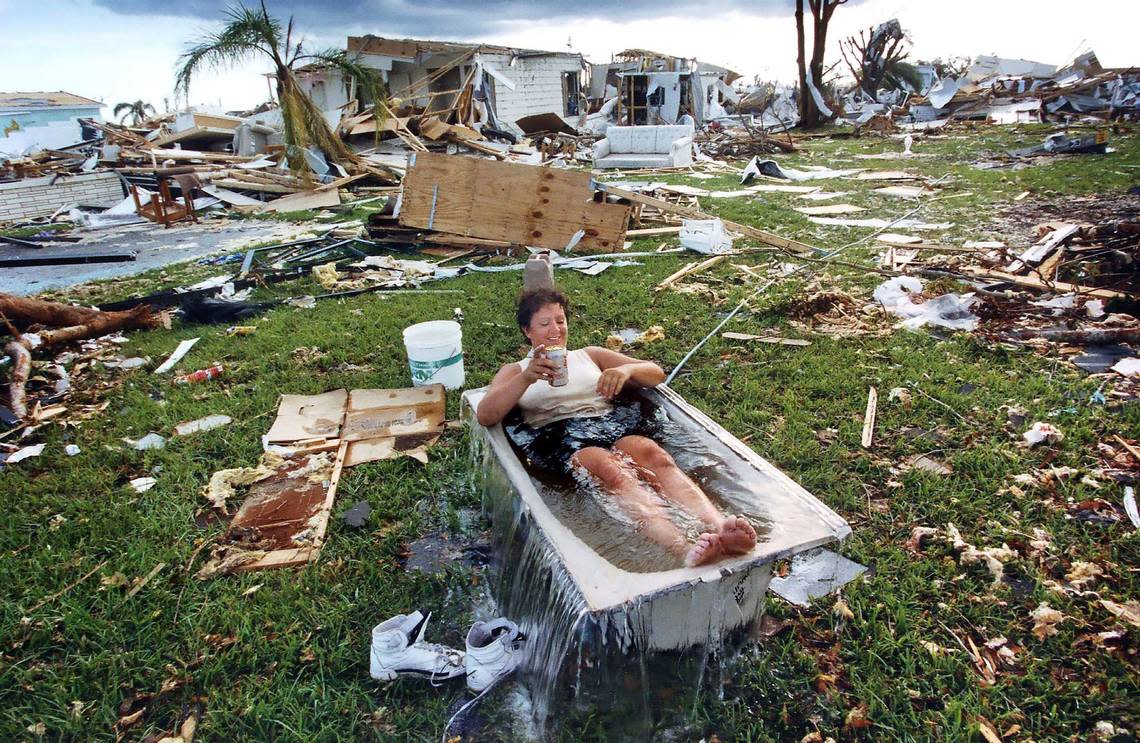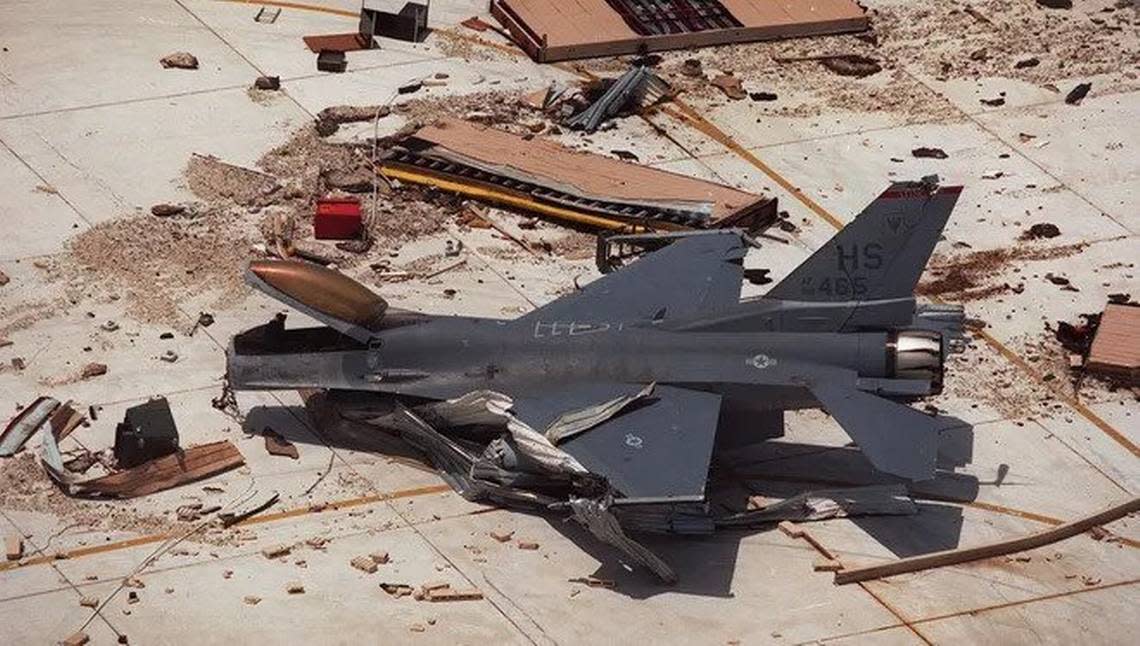‘I saw things that defied physics.’ What it was like to survive Hurricane Andrew in Miami
Hurricane Andrew all but destroyed parts of South Miami-Dade 30 years ago.
The Category 5 storm struck at dawn on Aug. 24, 1992, and left thousands of people homeless. The worst of it hit the southern portion of the county, which saw about 49,000 homes destroyed and another 108,000 damaged, according to the National Weather Service.
At the time, Andrew was the most expensive natural disaster in U.S. history. The storm was also deadly. Andrew killed 43 people in South Florida, with all but three deaths occurring in Miami-Dade, according to the National Weather Service.
What was it like to survive the storm?
We asked readers to share their memories of Hurricane Andrew. Here’s what you said. Some of the responses were edited for clarity and length.

‘I saw things that defied physics’
Michael Hearns worked as a detective for Coral Gables police when Andrew demolished his home near the Falls.
A tornado, he wrote, uprooted a mango tree and sent it crashing into his house. The tornado’s strong winds “lifted every piece of furniture up and deposited them against one corner of a back bedroom. Stacked all a kilter like some sort of large hand haphazardly pushed every piece on top of each other,” he wrote.
“The first night after Hurricane Andrew my team and I dug our way down south along Old Cutler Road. Inside Matheson Hammock, all along the service road, were large sailboats and yachts up in the top of the mangrove and pine tree lines,” Hearns recalled. “They looked like ghostly apparitions suspended in the air by the teetering branches. The salty water line of the storm surge had already started browning the branches and trunks of the trees.”
It was eerily quiet.
“I saw things that defied physics. Straw embedded in palm trees, serrated glass shards jutting out of lath and plaster walls, pre-fabricated swimming pool inserts eight to nine houses down from their original home site, cars flattened to the ground by large felled oaks,” Hearns wrote.
“It took me hours to not only find my home but to navigate to get there. The streets were unrecognizable.
Myself and my Coral Gables coworkers worked 12 hour shifts for weeks after Hurricane Andrew, and when we weren’t working, many of us were on work and recovery crews helping to secure homes of first responders and members of the community that were physically, or in many cases, emotionally challenged by the daunting task of recovery,” Hearns wrote.
Seaward Explorer: Iconic image of Andrew’s power
“Whenever the subject of Hurricane Andrew comes up, particularly on the anniversary date, I don’t think of that night during the storm when I was on duty as a police officer. I don’t think of the day I escorted a caravan of women construction workers to Homestead to help rebuild what was lost or the night I was on patrol in Homestead, relieving a Homestead police officer who had lost everything but the shirt on his back and had not slept in days.
I think of my brother and what I will always refer to as his ship, the Seaward Explorer,” wrote Teri Lee.

Lee said her brother Jerry was the original owner of the ship and did work for various agencies, including recovering booster rockets off the coast of Cape Canaveral after launches and oil explorations in the Gulf of Mexico, until he and his business partner were killed in a 1982 triple homicide in Miami.
Lee said the ship was then sold to Capt. Peter Skipp, who years later would find himself riding out Andrew with two crew members aboard the 105-foot research vessel-for-hire.
The ship, a converted offshore oil rig supply vessel, eventually came ashore just south of the Deering Estate along a canal spillway in the backyard of a mansion on old Cutler Drive. It remained there three months, “becoming a tourist attraction and an iconic image of Andrew’s power,” according to Herald archives.
“The damage to the ship could have been much worse. I like to think that perhaps my brother had a hand in protecting it from his watery grave in the Atlantic Ocean,” wrote Lee.
READ NEXT: ‘At the mercy of the storm.’ Captain recalls riding Hurricane Andrew on board his ship
‘Forever changed my life’
“This is a day that forever changed my life and one that I will not forget. My husband was one of 16 Florida Power & Light volunteer linemen to work during the storm. He was the last person to get the lights back on at Mercy Hospital just before the brunt of the storm.
A gust of wind down 27th Avenue pushed his 45,000-pound bucket truck up on two wheels but thankfully did not overturn it. Our home was severely damaged by the storm.
We found a 15-foot aluminum ladder in the bottom of our swimming pool (it wasn’t ours) and a pair of ladies frilly panties on the patio that weren’t mine! The storm ripped our pool filter right out of the ground and our chain link fence was nowhere to be found!
My husband’s boat, which sat in the backyard, had some water in the bilge, but not a scratch on it and it started right up when he turned the key. Of course our house was unlivable, but the boat survived!
— Carol Morse
‘Like the Mind Flayer from Stranger Things’
Julio Ligorría’s family took shelter in the hallway of their Calusa home, away from the windows, gathered together in sleeping bags. Then they heard a “huge bang that came out of nowhere.”
“The door had exploded and the hurricane was now fully raging in our living room, like the Mind Flayer from Stranger Things,” Ligorría wrote.
“Like startled cats we sprang to the nearest windowless bathroom and crammed all 10 of our family members in a bathroom that was comfortable enough for one person and a baby… maybe.”
After spending hours stuck inside “what amounted to a marble floored port-a-potty,” the storm passed and Ligorría went out with his siblings to assess the damage.
“My father’s collection of 12,000 compact disks laid encrusted in the neighborhood palm trees. Our neighbor’s creepy water bed, somehow, survived and was found on a street two blocks down.”
‘Pray to Jesus’
“I was raised in Miami, so I had already been through “Hurricane Betsy” and several others. Hurricanes were fun — no school, lots of junk food to eat ... until Hurricane Andrew. As an adult, it was very different. We were in our two-story home, listening to the radio, when the hurricane hit.
It started with the pool, screening and fencing. It ended with our entire home blown apart. We were in our downstairs guest bathroom all night, along with our two young daughters, our dog (which I rushed out of the bathroom to rescue), as well as my elderly father-in-law and his nurse.
We all had our eyes tightly closed. The girls and our dog were up on the bathroom counter, while we all stood in knee deep muddy water. My husband held a mattress against the door to keep it shut.
Then my father-in-law’s nurse started to ‘Pray to Jesus.’ Although I was raised Jewish, I started to chant along with her! At this point, I figured whatever works!!!
We emerged safe the next morning (of course we were also now homeless), so I guess her prayers helped us survive this terrifying night.”
— Nancy Sica
Bringing buckets of water to inmates
“I was a resident of the Homestead Federal Prison camp in the Homestead Air Force Base. We were moved a day before the hurricane hit South Florida to the Federal Correction by the zoo. The next morning (after Andrew struck) we woke up to no fences. We were low custody inmates and were ordered to bring water from the lake in buckets so the high level inmates, stuck in their cells without water or electricity, could flush their toilets.”
— Geo Diego

‘If you had beer, you could trade for anything’
Joshua Berkey was 17. His family lived in Cutler Bay, then known as Cutler Ridge. They rode out the storm at his aunt’s Homestead home, which had metal storm shutters.
“At some point, I remember hearing a horrendous metallic sound outside. About the time I realized that sound was the shutters getting ripped off the side of the house, the windows began to break, one after another,” Berkey wrote.
The family hid in a bathroom, which later got a leak. The power went out.
During the eye of the storm, the phone rang.
It was the next door neighbor. The front of her house had collapsed and she wanted to come over with her two kids. Berkey said they went to get her, and while outside, he saw a dog tied to an uprooted tree. The tree had “been dropped” in between four cars in a driveway.
He cut the dog’s leash with a knife, but the nervous pup wouldn’t move. He looked ready to bite.
Berkey went back inside. There were now 12 people hiding in the bathroom. They nailed the bathroom door shut.
“I’ll never forget that absolute howling sound the wind was making. Eventually the wind subsided and it was soon dawn. I remember walking outside and the first thing I looked for was the dog,” Berkey wrote. “It was gone. I like to think the dog made it.”
Berkey accompanied his uncle around power lines, downed trees and debris to his business on U.S. 1. He stood guard at the door with a shotgun to keep looters away while his uncle got valuables from the safe.
“It was two days before the roads were clear enough to get back to our home in Cutler Ridge. We got lost in our own neighborhood. No street signs, no landmarks, nothing looked the same,” Berkey wrote. “Roads we’d traversed a 1,000 times before looked completely foreign.”
His family used water jugs from his aquarium to collect trickling tap water, which they left in the sun to heat up. At night, they would get on a step ladder and pour the water on top of each other to shower. They slept in tents in the front yard because it was too hot inside their home. It took six to eight weeks to get power.
“Since all the fences blew away, you actually got to meet your neighbors. You also had to rely on them. Someone had a chainsaw. Someone else had extra food. The electrician down the street would help with your generator. And beer. If you had beer, you could trade for anything,” Berkley wrote.
“Everyone pitched in and helped out. It’s truly the only time I felt like I was part of a community ... Having said that, I never want to go through the eye of another Category 5 hurricane ever again.”
READ MORE: These places were damaged or destroyed by Hurricane Andrew. Did they make a comeback?
